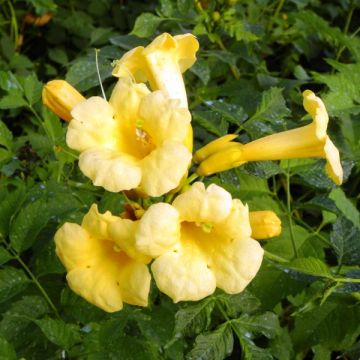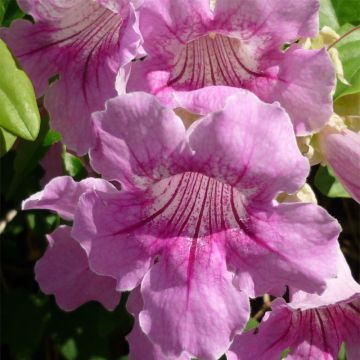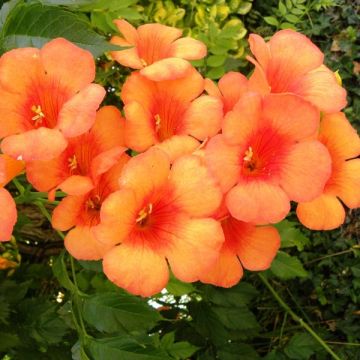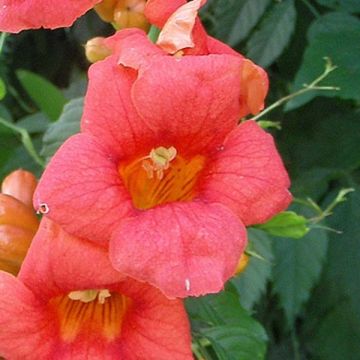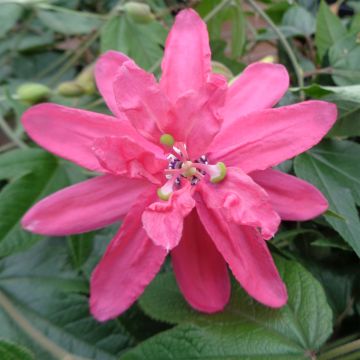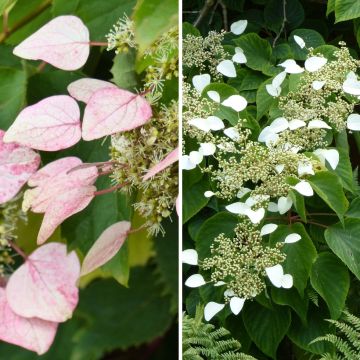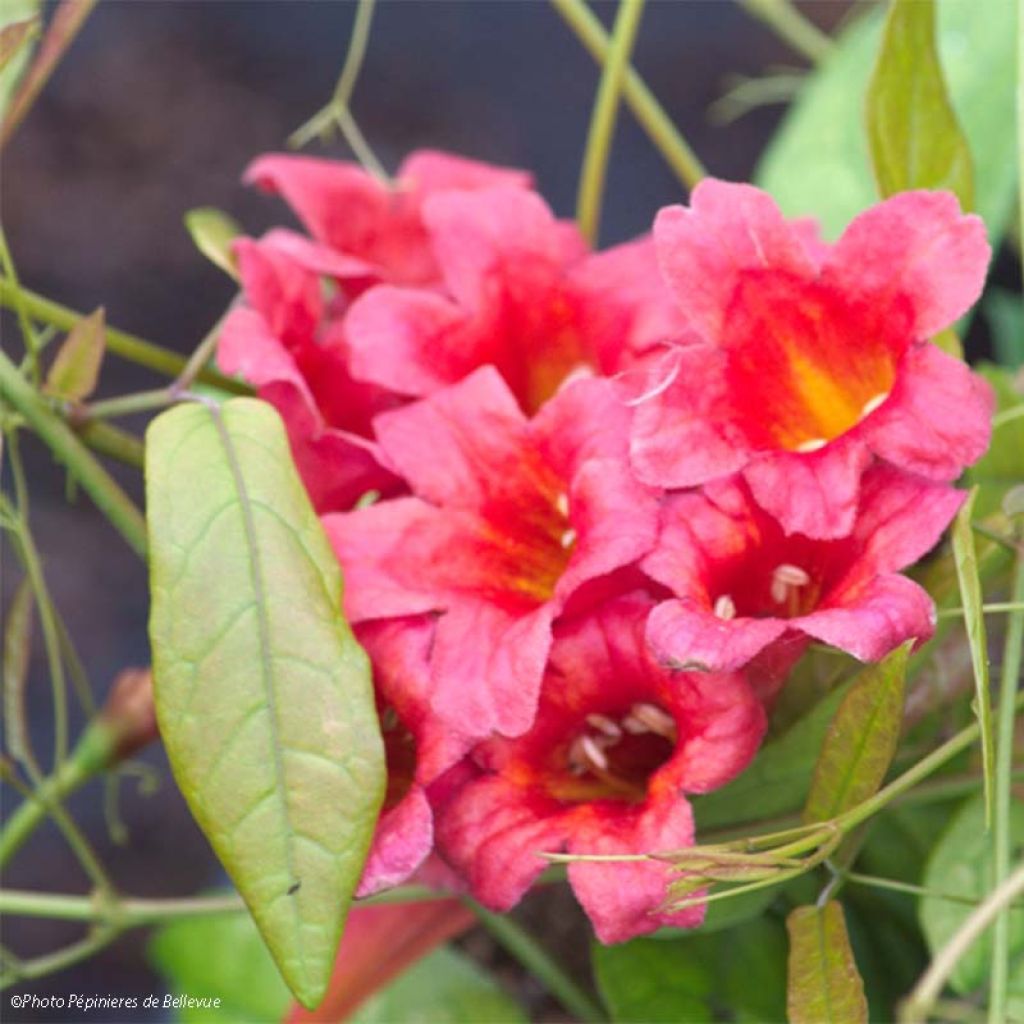

Campsis capreolata Atrosanguinea
Campsis capreolata Atrosanguinea
Campsis capreolata Atrosanguinea
Trumpet Flower
This item cannot be shipped to the selected country
Delivery charge from €5.90
More information
Schedule delivery date,
and select date in basket
This plant carries a 6 months recovery warranty
More information
We guarantee the quality of our plants for a full growing cycle, and will replace at our expense any plant that fails to recover under normal climatic and planting conditions.
From €5.90 for pickup delivery and €6.90 for home delivery
Express home delivery from €8.90.

Does this plant fit my garden?
Set up your Plantfit profile →
Description
Campsis capreolata 'Atrosanguinea' differs from the typical climbing trumpet vine only by its very dark red flowers, illuminated by yellow flags. It is a large climbing vine that blooms from April to July and then in September with long trumpets that release a unique fragrance, combining the round and sweet notes of chocolate with the more bitter notes of roasted coffee. Its foliage, tough and evergreen in not too cool climates, is dark green and has violet reflections in winter. Undemanding in terms of soil type, perfectly resistant to drought, moderately hardy, it will thrive in full sun or partial shade in hot climates.
Campsis capreolata is a species in the Bignonia family, native to the hot and dry regions of the southeastern United States. It is an evergreen climber with a woody stump and rapid growth, reaching 8 to 10 meters (26 to 33 feet) in height in a few years, even more in the wild. The plant attaches itself to its support using highly effective branching tendrils equipped with small discs that adhere like suction cups to even the smoothest surfaces. The flowering period is very spread out, starting in April in mild climates and continuing until June-July, then blooming again in September. The flowers bloom in the axils of the leaves, in dense clusters of elongated trumpets, 5 cm (2in) long, with 5 yellow lobes and a very dark red-purple coloration in their tubes. Their surprising and sweet fragrance evokes both chocolate and coffee, like that of a toffee. The flowering is followed by the formation of 15 cm (6in) long pods containing the seeds. The foliage, normally evergreen, often becomes deciduous in cool climates. It is composed of leaves with four leaflets, the two farthest from the stem being thin tendrils that allow the plant to attach itself. If it persists, the foliage takes on a slightly violet coloration in winter. The bark of this climber is a greyish-brown colour and cracks with age.
Campsis or Bignonia capreolata 'Atrosanguinea' can be used anywhere, to cover a wall sheltered from cold winds, an unsightly building, a south-facing facade, a fence, or a trellis. This plant can tolerate short periods of freezing temperatures around -12°C (10.4°F) and absolutely needs to be protected during the first years of cultivation in cold climates. This is its only requirement and probably its only weakness. It grows in well-drained and dry soils, even limestone or poor soils, which do not prevent it from flowering joyfully.
Report an error about the product description
Campsis capreolata Atrosanguinea in pictures




Plant habit
Flowering
Foliage
Botanical data
Campsis
capreolata
Atrosanguinea
Bignoniaceae
Trumpet Flower
Cultivar or hybrid
Other Campsis - Trumpet Creeper
Planting and care
Bignonia or Campsis capreolata is a plant that is undemanding in terms of soil type. It grows in any well-drained garden soil, even if it is quite poor and limestone. It prefers a sunny exposure, except in the south of our country where it will thrive in partial shade. Plant it along a well-exposed wall or against a tree, guiding its first steps with a support. Water it moderately during the first summers, as the plant can withstand extended periods of drought once established. In the first few years, protect its stump from severe frosts with a thick mulch. Pruning is not essential. If necessary, you can do it in spring. In August-September, remove the faded branches as well as the oldest shoots, which can be recognised by their cracked bark.
Planting period
Intended location
Care
-
, onOrder confirmed
Reply from on Promesse de fleurs
Summer flowering climbers
Haven't found what you were looking for?
Hardiness is the lowest winter temperature a plant can endure without suffering serious damage or even dying. However, hardiness is affected by location (a sheltered area, such as a patio), protection (winter cover) and soil type (hardiness is improved by well-drained soil).

Photo Sharing Terms & Conditions
In order to encourage gardeners to interact and share their experiences, Promesse de fleurs offers various media enabling content to be uploaded onto its Site - in particular via the ‘Photo sharing’ module.
The User agrees to refrain from:
- Posting any content that is illegal, prejudicial, insulting, racist, inciteful to hatred, revisionist, contrary to public decency, that infringes on privacy or on the privacy rights of third parties, in particular the publicity rights of persons and goods, intellectual property rights, or the right to privacy.
- Submitting content on behalf of a third party;
- Impersonate the identity of a third party and/or publish any personal information about a third party;
In general, the User undertakes to refrain from any unethical behaviour.
All Content (in particular text, comments, files, images, photos, videos, creative works, etc.), which may be subject to property or intellectual property rights, image or other private rights, shall remain the property of the User, subject to the limited rights granted by the terms of the licence granted by Promesse de fleurs as stated below. Users are at liberty to publish or not to publish such Content on the Site, notably via the ‘Photo Sharing’ facility, and accept that this Content shall be made public and freely accessible, notably on the Internet.
Users further acknowledge, undertake to have ,and guarantee that they hold all necessary rights and permissions to publish such material on the Site, in particular with regard to the legislation in force pertaining to any privacy, property, intellectual property, image, or contractual rights, or rights of any other nature. By publishing such Content on the Site, Users acknowledge accepting full liability as publishers of the Content within the meaning of the law, and grant Promesse de fleurs, free of charge, an inclusive, worldwide licence for the said Content for the entire duration of its publication, including all reproduction, representation, up/downloading, displaying, performing, transmission, and storage rights.
Users also grant permission for their name to be linked to the Content and accept that this link may not always be made available.
By engaging in posting material, Users consent to their Content becoming automatically accessible on the Internet, in particular on other sites and/or blogs and/or web pages of the Promesse de fleurs site, including in particular social pages and the Promesse de fleurs catalogue.
Users may secure the removal of entrusted content free of charge by issuing a simple request via our contact form.
The flowering period indicated on our website applies to countries and regions located in USDA zone 8 (France, the United Kingdom, Ireland, the Netherlands, etc.)
It will vary according to where you live:
- In zones 9 to 10 (Italy, Spain, Greece, etc.), flowering will occur about 2 to 4 weeks earlier.
- In zones 6 to 7 (Germany, Poland, Slovenia, and lower mountainous regions), flowering will be delayed by 2 to 3 weeks.
- In zone 5 (Central Europe, Scandinavia), blooming will be delayed by 3 to 5 weeks.
In temperate climates, pruning of spring-flowering shrubs (forsythia, spireas, etc.) should be done just after flowering.
Pruning of summer-flowering shrubs (Indian Lilac, Perovskia, etc.) can be done in winter or spring.
In cold regions as well as with frost-sensitive plants, avoid pruning too early when severe frosts may still occur.
The planting period indicated on our website applies to countries and regions located in USDA zone 8 (France, United Kingdom, Ireland, Netherlands).
It will vary according to where you live:
- In Mediterranean zones (Marseille, Madrid, Milan, etc.), autumn and winter are the best planting periods.
- In continental zones (Strasbourg, Munich, Vienna, etc.), delay planting by 2 to 3 weeks in spring and bring it forward by 2 to 4 weeks in autumn.
- In mountainous regions (the Alps, Pyrenees, Carpathians, etc.), it is best to plant in late spring (May-June) or late summer (August-September).
The harvesting period indicated on our website applies to countries and regions in USDA zone 8 (France, England, Ireland, the Netherlands).
In colder areas (Scandinavia, Poland, Austria...) fruit and vegetable harvests are likely to be delayed by 3-4 weeks.
In warmer areas (Italy, Spain, Greece, etc.), harvesting will probably take place earlier, depending on weather conditions.
The sowing periods indicated on our website apply to countries and regions within USDA Zone 8 (France, UK, Ireland, Netherlands).
In colder areas (Scandinavia, Poland, Austria...), delay any outdoor sowing by 3-4 weeks, or sow under glass.
In warmer climes (Italy, Spain, Greece, etc.), bring outdoor sowing forward by a few weeks.





































